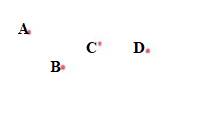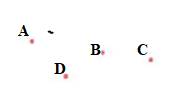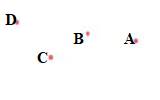
Concept explainers
The different ways in which a diagram can be labeled.
Answer to Problem 13PSC
The different ways in which a diagram can be labeled are ABCD , ABDC , ADBC , ADCB ,ACBD , ACDB , DCBA , CDBA , BCDA ,CBDA , DBCA , BDCA ,DCAB , CDAB , DBAC , BDAC, BCAD , CBAD.
Explanation of Solution
Given information:
4 points are given in a plane.
Concept used:
Calculation:
For A to be collinear with two other points, A can be at 3 positions first , third and fourth.
and remaining 3 letter can be arrange in 3 positions in
ABCD , ABDC , ADBC , ADCB ,ACBD , ACDB , DCBA , CDBA , BCDA ,CBDA , DBCA , BDCA ,DCAB , CDAB , DBAC , BDAC, BCAD , CBAD.
Conclusion:
Hence with given condition the diagram can be labeled in 18 different ways -
Few of these labeling are −









Chapter 1 Solutions
Geometry For Enjoyment And Challenge
Additional Math Textbook Solutions
Calculus: Early Transcendentals (2nd Edition)
A First Course in Probability (10th Edition)
Basic Business Statistics, Student Value Edition
Elementary Statistics
Algebra and Trigonometry (6th Edition)
Elementary Statistics: Picturing the World (7th Edition)
- Door 87.5in to 47 living 44.75 Closet 96in Window ISS.Sin 48in Train Table 96in 48in 132:2 Windowarrow_forward39 Two sides of one triangle are congruent to two sides of a second triangle, and the included angles are supplementary. The area of one triangle is 41. Can the area of the second triangle be found?arrow_forwardA parallelogram with an area of 211.41 m^2 hast a base Thatcher measures 24.3m. Find ist height.arrow_forward
 Elementary Geometry For College Students, 7eGeometryISBN:9781337614085Author:Alexander, Daniel C.; Koeberlein, Geralyn M.Publisher:Cengage,
Elementary Geometry For College Students, 7eGeometryISBN:9781337614085Author:Alexander, Daniel C.; Koeberlein, Geralyn M.Publisher:Cengage, Elementary Geometry for College StudentsGeometryISBN:9781285195698Author:Daniel C. Alexander, Geralyn M. KoeberleinPublisher:Cengage Learning
Elementary Geometry for College StudentsGeometryISBN:9781285195698Author:Daniel C. Alexander, Geralyn M. KoeberleinPublisher:Cengage Learning

